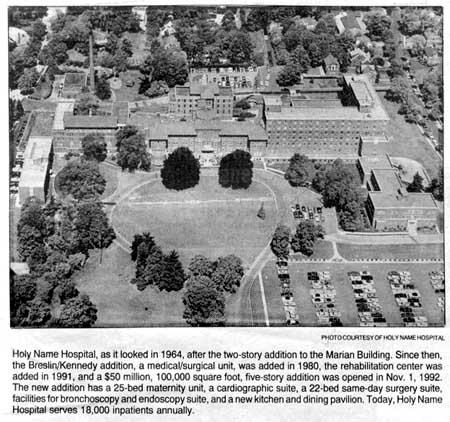Taking a Look at Turn-of-the-Century Cedar Lane
By LARRY J. ROBERTSON
Ever wonder what Cedar Lane looked like in turn-of-the-century Teaneck?
It was much narrower, with steeper grades (for example, from Palisade Avenue to Queen Anne Road). Cedar Lane Road ran from the Anderson Street bridge east to a smaller wooden bridge over Overpeck Creek /Englewood Drainage Canal and into the Nordhoff section of Englewood. Landowner William Walter Phelps made sure it was paved and widened and the worst grade lowered.
 If one were to start at the Hackensack River, one would see only about six buildings actually fronting Cedar Lane from there to the railroad. The first house was a county building in which the bridge tender for the Anderson Street swing bridge lived. There was also a small store of some kind, possibly a fruit or fish stand, one of only two commercial buildings.
If one were to start at the Hackensack River, one would see only about six buildings actually fronting Cedar Lane from there to the railroad. The first house was a county building in which the bridge tender for the Anderson Street swing bridge lived. There was also a small store of some kind, possibly a fruit or fish stand, one of only two commercial buildings.
One of the three houses near the river bridge was inhabited by an African-American family, the Billings, headed by a fisherman whose wife was a laundress. One son was a coachman. Pomander Walk existed, but was called Riverside Avenue. Two large mansions were south of Cedar Lane, and another north of it, on the knoll where Fairleigh Dickenson University's Linden dormitories now stand.
River Road and Cedar Lane, then as now, was a busy intersection, but with large farms and working class homes nearby. South of Cedar Lane, River Road was called Bogota Road. North of Cedar Lane, two large commercial enterprises added to traffic, Red Tower commercial nursery and the Henderson Seed Company, both in the vicinity of FDU's main campus and Weiner Library.
Near the present Catalpa Avenue lived Rev. George C. Holland, an African-American clergyman of Mount Olive Baptist Church in Hackensack.
No commercial buildings fronted on Cedar Lane up to the railroad until the 1920s. Three dwellings stood on the north side: Rev. Holland's, Teaneck's first general contractor Samuel Garrison's (near Garrison Avenue), and another near the railroad, occupied by the railroad telegrapher and his family.
Until 1926, Cedar Lane crossed the railroad tracks at grade level with the incredibly steep hill up to Queen Anne Road, then called Westfield Avenue.
At the turn of the century, there were two through tracks and two sidings, one of which extended across Cedar Lane, so it was a three-track crossing. The passenger station was at the foot of Cherry Lane, behind the present Limone's Farm. Palisade Avenue, from Cedar Lane to Cherry Lane, was probably called Heasly Avenue at the time. The only buildings were the passenger station and the freight station. South of Cedar Lane, Palisades Avenue was a meandering dirt track.
 Where Barr Avenue and Carroll Place now intersect, south of Cedar Lane, was a huge horse establishment, Fiss, Doer, and Carroll, where horses were prepared for service on urban street railways. Later, from 1914 to 1918, artillery horses were trained and shipped out to the various allied armies. While the massive stables were set back from Cedar Lane, one of the buildings of the complex stood about where Hudson City Bank is located. Heading east, possibly where the Texaco station now stands, was the blacksmith shop of William T. Robertson. Large barns and a grain-threshing floor (or grange) were set back about 200 feet north of Cedar Lane between Queen Anne and Grange roads. A small dwelling existed where Acme supermarket's parking lot is now. Red Road was a Phelps riding trail. Where Prince Street is was a large stable and other buildings of the Phelps estate. On the east side of Teaneck Road was the home of the Countess Castlemenardo, daughter of Gen. Van Buren. This land is now occupied by the Volk Leber Funeral Home. Teaneck Road was called Washington Avenue north of Cedar Lane. On the northwest corner of Cedar and Teaneck, where the municipal building stands, were the ruins of Phelps' first Teaneck home, predating 1869, that had been completely destroyed by an acetylene explosion fire on April 1, 1888.
Where Barr Avenue and Carroll Place now intersect, south of Cedar Lane, was a huge horse establishment, Fiss, Doer, and Carroll, where horses were prepared for service on urban street railways. Later, from 1914 to 1918, artillery horses were trained and shipped out to the various allied armies. While the massive stables were set back from Cedar Lane, one of the buildings of the complex stood about where Hudson City Bank is located. Heading east, possibly where the Texaco station now stands, was the blacksmith shop of William T. Robertson. Large barns and a grain-threshing floor (or grange) were set back about 200 feet north of Cedar Lane between Queen Anne and Grange roads. A small dwelling existed where Acme supermarket's parking lot is now. Red Road was a Phelps riding trail. Where Prince Street is was a large stable and other buildings of the Phelps estate. On the east side of Teaneck Road was the home of the Countess Castlemenardo, daughter of Gen. Van Buren. This land is now occupied by the Volk Leber Funeral Home. Teaneck Road was called Washington Avenue north of Cedar Lane. On the northwest corner of Cedar and Teaneck, where the municipal building stands, were the ruins of Phelps' first Teaneck home, predating 1869, that had been completely destroyed by an acetylene explosion fire on April 1, 1888.

